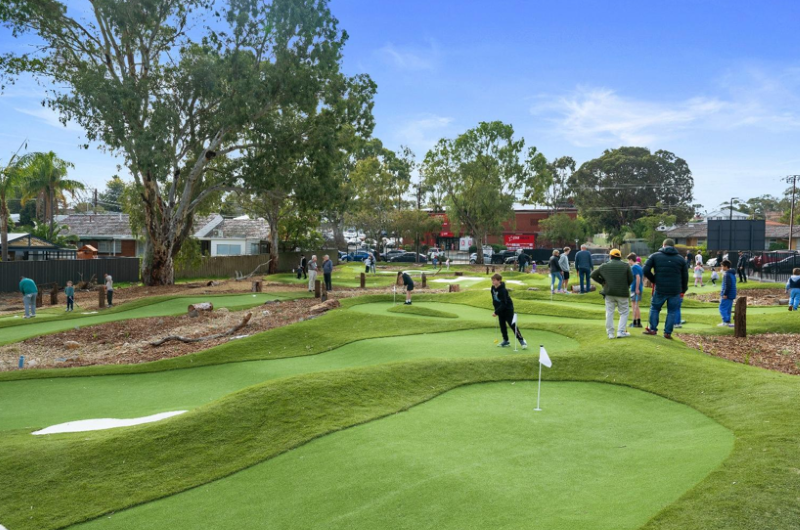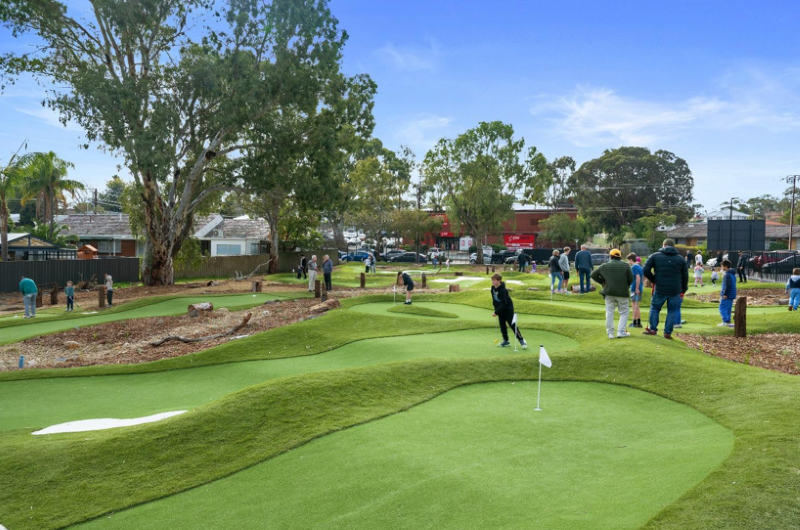
The 18 hole putting course being enjoyed by all ages and skill ability
Adelaide’s Flagstaff Hill Golf Club’s ambitious clubhouse area redevelopment, designed and built by Himalayas Golf, is now complete, marking a new era for the club and setting a new standard for golf facilities in Australia. With all four phases of the golf aspect of the transformation officially open to the public, the club has successfully created a world-class destination for golfers of all skill levels.
The Vision Behind the Project
According to General Manager Chris Coulter, the project was driven by a major redevelopment with Living Choice Australia, an independent retirement living company. Coulter stated that “the Club was looking to add multiple revenue-generating areas”, including a putting course. The main goal for the putting course was to “produce a quality and enjoyable mini-golf course that people would travel to from all over Adelaide.” The short game practice facility was designed and built to compensate for the loss of the club’s driving range to the new developments. It was intended to “allow as much diversity as possible” for players to practice a wide variety of shots.
A Look at the Completed Facilities
Artificial Turf Practice Green and Wedge Target Greens:
This phase was the first to open and has been a resounding success. Sitting adjacent to the new 10th tee, and covering a total area of 350m² with a 210m² putting surface, the green features the same cutting-edge artificial turf and underlay system as the TGL (Tomorrow Golf League) in Florida. Designed with practice in mind, it includes various modules from short game guru, Dave Pelz, and is lauded for its consistency and quality. The next step is to add lighting to this area to allow residents and members to use the facility at night, and tidy up the remaining construction work of adjacent buildings.
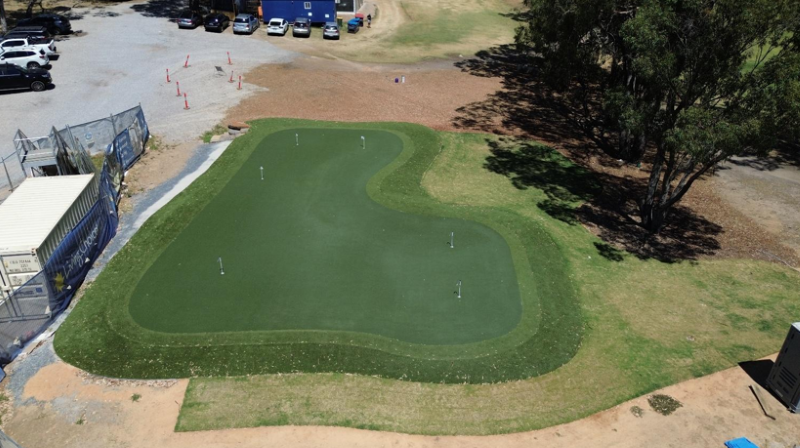
The artificial turf green prior to the wedge target greens being constructed.
Adjacent to the artificial putting green are wedge target greens – a training tool designed by the world renowned short game coach, Dave Pelz. With 4 circular greens spaced at 10m intervals from 20m to 50m, the radius of each green is the proximity that the average PGA tour player hits their approach shot to from that distance. Land on the green and you are better than the tour average. This facility allows the golfers to work on their wedge distance control – helping them get up and down more often – reducing their scores.
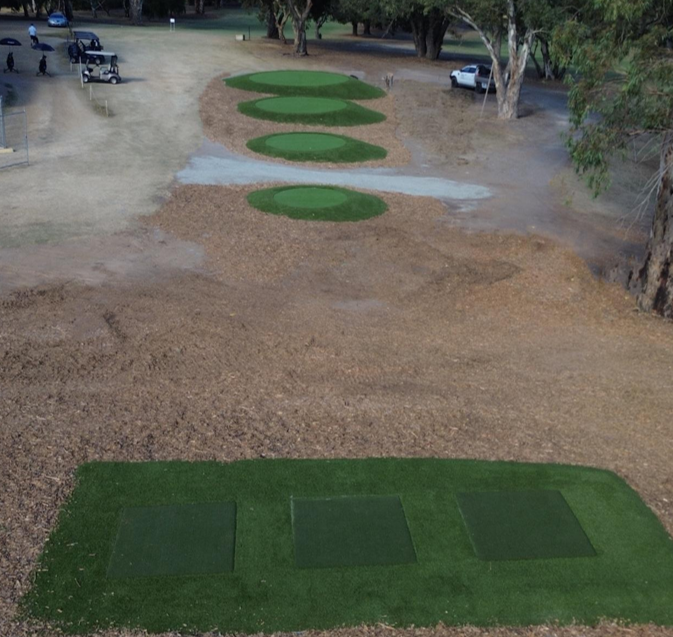
The wedge target greens with space for 3 golfers to practice simultaneously.
Improved Opening Hole:
The club’s first hole has been significantly improved. The fairway’s landing area and ridge line were stripped to provide a clear, unobstructed view of the green from the new, realigned, and raised tee box. The strategic reuse of cut materials for other project areas (short game area and putting course) highlights the project’s resourceful approach.
Short Game Practice Facility and First Tee Box Complex:
This new facility features two bent grass greens totalling just over 1,100m², along with warm-up nets. A bunker and various undulations mimic on-course scenarios, and a unique scorecard system allows players and coaches to track their progress and “Practice With Purpose”.
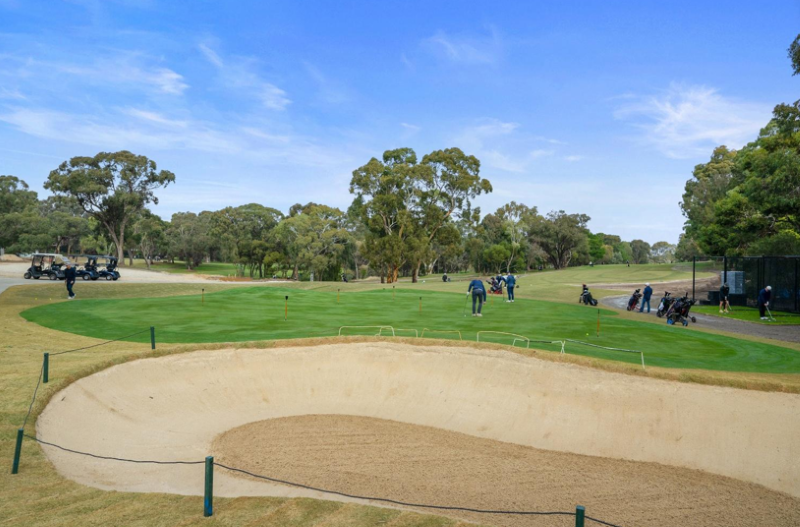
The new short game area showing one of the practice greens and looking down the first fairway.
18-Hole Artificial Turf Putting Course:
Coulter describes the completed mini-golf course as “terrific” and that it has been the most talked about aspect of the club’s developments as it is the first thing that you see when you arrive at the club. He notes that the design met the brief to “make each hole containable” ensuring that only very bad shots would leave the playing surface, whilst memorable enough to promote return visits. The course’s varied design has been a hit with the public, with many people returning for repeat visits. Coulter further added that it has “been enjoyable for all ages” and “it is a good length with variation throughout the course”. The landscaping, although needing a full season to establish itself, is all native and endemic plants – minimising the maintenance and upkeep for the club.
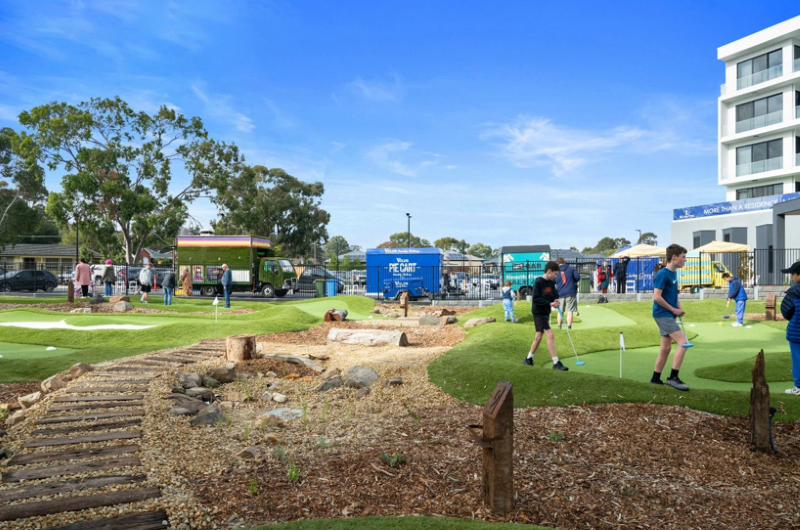
The 18 hole putting course being well utilized by all ages.
Initial Success and Member Feedback
The putting course has become a major attraction and revenue generator, with Coulter stating, “the mini golf has brought many non-golfers to the course,” adding that many of them have since joined as social members, as well as converting a few younger players into junior members. The high visibility of the mini-golf course from the entrance and the nearby shopping center has made it a significant talking point and a driver of new visitors. Further to this, many players stay at the club to eat and have drinks following their round on the putting course. All of this helps strengthen the club’s financial position.
Coulter reports that the feedback on the short game area has also been excellent, with serious golfers enjoying the green design to allow golfers to practice a variety of shots and putts.
Coulter also had no hesitations about using artificial turf, confident that the final product would look and play great. The minimal maintenance required for these areas has been a “huge positive” for the club.

The 18 hole putting course encourages the entire family to play golf together.
Collaboration and Future Plans
Coulter praises Himalayas Golf for their collaborative approach, stating they “listened to our needs and expectations” and that their use of the available land was “spot on.” The final product not only met but exceeded expectations. Flagstaff Hill Golf Club looks forward to working with Himalayas Golf again in the future to execute a master plan for the rest of the golf course.

